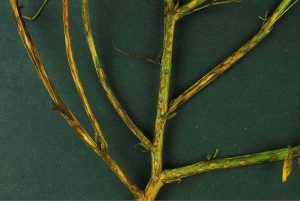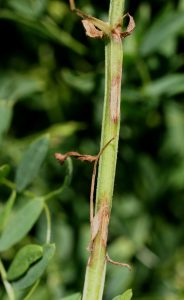Note: Lentil anthracnose is an exotic disease and has not been detected in Australia to date.
Lentil anthracnose is a serious disease of lentil worldwide. It has been identified in Bangladesh, Bulgaria, Canada, Ethiopia, Morocco, Pakistan, Syria and the USA. This disease is most serious in Canada where it causes yield losses of up to 60 per cent. Lentil anthracnose is caused by the fungal pathogen Colletotrichum truncatum. Screening of Australian breeding lines in Canada has shown that current lentil varieties in Australia are all highly susceptible to this disease.
What to Look For
In most lentil crops, the first symptoms of anthracnose appear before flowering when the plants have 8 to 12 nodes on the main stem. This is also the time when the first tendrils form and approximately a week before flowers start to open. If there is a large amount of inoculum in the field the first symptoms may appear earlier. The initial symptoms of lentil anthracnose are greenish water-soaked lesions on the lower stems and leaves that become necrotic with time. Tan coloured lesions of variable size develop on the lower leaflets and the most severely affected leaflets die prematurely and drop to the ground. Creamy white lesions are also sometimes evident on the upper foliage.
Small, pinhead sized fungal structures (microsclerotia) form on the older infected plant tissue. They may be seen with the unaided eye in the centre of stem lesions or more easily with a hand lens (10-15x magnification). Each microsclerotia consists of a few hundred cells with thick, black cell walls that protects the fungus from colonisation by other microorganisms. Microsclerotia enable the fungus to survive between lentil crops either on the plant debris or free in the soil. They remain viable longer when buried in the soil by tillage than left exposed to weather extremes on the soil surface. These fungal structures survive on dead lentil debris or in the soil during periods when a host is not available.
During flowering, lesions on stems develop soon after the appearance of leaf lesions primarily at the base of the plant. Stem lesions may be small, brownish with a black border, or larger, stretching along the stem. As the season progresses, more and more golden-brown lesions develop at the stem base, as well as on the upper part of the stems and many stems are girdled. Finally, there is a marked blackening of old infected tissues due to the production of stromatic mycelium (microsclerotia) under acervuli.
Anthracnose causes defoliation and stem girdling which inhibits utilisation of water and nutrients and causes the lentil plants to wilt. The fungus girdles the stem resulting in wilting of the entire plant, and large areas of brown and dying plants in the field.

Distinct stem lesions caused by Colletotrichum truncatum infection. These are pale brown with a black border and irregular in shape.
Disease Cycle
The disease can survive on infected lentil seed, plant debris and in the soil. Seed-borne inoculum is considered to be of minor importance in Canada. Infected seed will give rise to infected seedlings, which can establish the disease in new crops and in new areas. Infected stubble residues and dust play a more important role in the spread and survival of this pathogen. Windblown residues and dust spread the disease into nearby paddocks and new lentil crops. Microsclerotial fruiting bodies, formed on infected plant tissue, allow the pathogen to survive in the soil for up to 4 years in the absence of lentil hosts.
Management
Current management strategies in Canada involve the use of foliar fungicides to protect plants from infection. There are no resistant varieties currently available, although, they are being developed.





